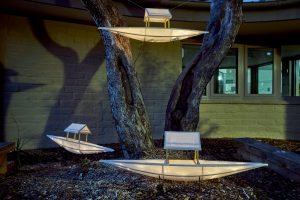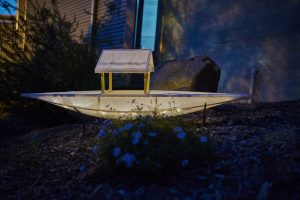Case Study 2: The Anonymous Sojourners in the Australian Bush
St Andrews, Melbourne, Victoria, Australia, 2017
The Anonymous Sojourners in the Australian Bush (2017) was a collaborative public art commission located in the peri-urban edge of Melbourne’s north-eastern region, 52 kilometres from the city centre. Part of the local Shire’s Living in the Landscape Public Art Incubator program, I collaborated with the local organisations of Men’s Shed, Historical Society and Wadambuk Community Centre. The project focused on the little-known history of Chinese miners who were present in the town during early colonial settlement in the 1850s and later buried there. The project centred around the co-creation of a series of eight white boat lanterns which lit up each night over the summer months of 2017-18 to commemorate the contributions of the deceased Chinese mining community permanently located in St Andrews. The lantern boats draw inspiration from Chinese burial traditions, symbolically returning those who intended to return under the moonlight of St Andrews, as the full moon represents family union in Chinese culture. The lanterns were white, the colour used in traditional Chinese funerals and also in reference to the ‘whiting out’ of history in a colonial society. The project developed through co-learning community engagement over the course of six months.

The surrounding area is rural and contains large properties, some of which form the local winery. The town centre is quaint and somewhat isolated. During the initial stages of the project, as an artist/researcher, I was aware of the lack of visible cultural diversity of the local area, quite the opposite of the Broadmeadows community, dense and populated with new immigrants. This provided a whole new context for my research. My early research into the area was informed by townsite visits and the review of available heritage information. Little documentation exists on the original uses of the land by the Wurrundjeri people of the Eastern Kulin Nations, the Indigenous inhabitants of the area who have thousands-year-old oral histories. Most institutionalised records begin with the early colonial settlement brought about by local 1850s gold mining activity in what was then known as Queenstown. As I scanned said historical documents, I was alerted to a Chinese community history during the early days of settlement, denoted secondarily: “(and Chinese)”. These parentheses piqued my curiosity. Who made up this Chinese afterthought? Where is the community? Is there still any evidence of their existence?
My interest in this glossed-over history led to the discovery that there were over thirty graves of male Chinese miners not commonly known about in St Andrews, men aged between their mid 20s-mid 90s, buried in the late nineteenth and early twentieth centuries in Queenstown Cemetery (in the heart of what is now St Andrews). My mind automatically harkened back to ‘hungry ghosts’, those ancestors who return to haunt human society if they pass on with unresolved issues. Descendants can appease ‘hungry ghosts’ by leaving them offerings of food, goods and well wishes. Only twenty-five of the graves were identified based on the death inquest reports, archived by the historical society. The names such as ‘Ah Wah’, ‘Ah Sam’ and ‘Ah Choon’ indicate Cantonese-Chinese heritage (from Guangzhou Province, China) as these are not complete full names, but abbreviated commonly used names. The ‘Ah’ is an expressive used in front of the last character of a Cantonese name and is the short form of a name for someone who is familiar with that person. After gold was discovered in Victoria in 1850, many Cantonese-Chinese people immigrated to Australia as mining labourers and were one of the earliest non-white immigrant groups in the colony, notably the second group to be marginalised by white settlers, after the original Indigenous inhabitants.
The text below is taken from one of the death inquest reports provided by the project’s supporter, St Andrews Historical Society. It indicates the perilousness of the miners’ working conditions:
Ah Choon
The inquest was held on June 17 1881
‘I am a miner residing with Shin Cum – I knew the deceased Ah Choon.
Yesterday morning, about 8 o’clock, I saw him going to his work –
In the evening, I went with Shin Cum and dug out the body of Ah Choon.
We found him buried in earth, which had fallen upon him.
He was lying face downward.
He was quite dead –The deceased worked by himself’.
Cum Sue
Sworn native of China
Although many of the miners had ambitions to work as sojourners (to only stay temporarily), many did not survive the harsh conditions of the mining sites. Upon learning of this sad history of the Cantonese community, I proposed to work with the current community and the Chinese Museum to gain a better understanding of their history and to work with the St Andrews Men’s Shed to design, build and implement a project honouring them.
The Men’s Shed stems from a uniquely Australian concept, where community sheds are established for men to socialise, connect, participate and learn from each other in a workshop environment. Barry Golding, an education professor who has researched men’s learning in relation to men’s sheds, identifies that for older men there is a preference to participate in informal education in a workshop environment through activities, playfully coining the term ‘Shedagogy’ (Golding, 2014). The conditions produced by this environment became ideal for collaborative project development, and although the community generally did not culturally relate to the miners, they were fascinated with their local area’s unrecognised history and were keen to work on the project. In developing an understanding of this history, they demonstrated significant empathy for the deceased and embraced this history as an important part of St Andrews as a place. In particular, two of the members with an interest in art and design became project leads and dedicated their time to the project, contributing their incredible skills of craftsmanship to the design and building of the structures. Many of the other members also devoted their spare time to supporting the construction, electrical work and installation involved.
As we conversed about the project, I became inspired by this well-known Tang Dynasty poem by Li Bai expressing feelings of homesickness as an immigrant on the Silk Road, where the speaker looks to the moon and is reminded of being reunited with his family and home:
Thoughts on a Tranquil Night
Li Bai (701-762 BC)
Beside my bed, a pool of light
Is it frost on the ground?
I lift my eyes and see the moon
I bow my head, feeling a longing for home
(translated from Chinese)
The final products of the project were the following: A silhouette of the full moon appeared in the lanterns when they were lit up. The text of the above poem was placed next to the lanterns, as a reminder of the feelings expressed by those who did not return and to provide an alternative cultural reading to the miserable death inquest reports that remain as evidence of the deceased community.
The process of discovery and research, the development of the project and community relationships, and the public launching of the project gave new awareness to the historical layers of community in St Andrews. The project acknowledged the Cantonese-Chinese community’s little-known contribution to the colonial society and metaphorically returned the group to their homes, families and communities, who have missed each other for several generations. It was my attempt to appease the ‘hungry ghosts’ of the community by working with St Andrews groups, to rediscover and make public this history.

